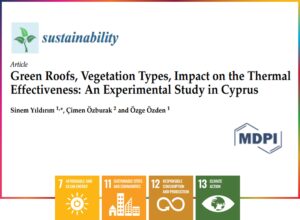
Yıldırım, S., Özburak, Ç., & Özden, Ö. (2023). Green Roofs, Vegetation Types, Impact on the Thermal Effectiveness: An Experimental Study in Cyprus. Sustainability, 15(3), 2807.
A recent study, co-authored by Sinem Yıldırım, Çimen Özburak, and Özge Özden from Near East University, delved into the significant impact of green roofs on urban environments, particularly in semi-arid regions such as Cyprus. The research, conducted over twelve months at the Near East University Campus, aimed to evaluate the effectiveness of various green roof vegetation types in moderating indoor temperatures and reducing energy consumption.
The study compared three distinct green roof setups with a control roof lacking vegetation, insulation, and soil. Using Elitech RC-5 temperature data loggers, the research monitored indoor temperatures in huts with different green roof configurations. The findings showcased that green roof-equipped huts maintained lower mean temperatures, particularly during scorching summer periods. Notably, huts featuring shrub plants exhibited the most significant cooling effects, emphasizing the pivotal role of dense vegetation cover in mitigating high indoor temperatures.
This research aligns with existing studies, reaffirming the seasonal and thermal benefits of green roofs. Crucially, it highlights the relevance of green roof technology in addressing the challenges posed by urban heat and climate change. In the context of Cyprus' arid Mediterranean climate, the study underscores how green roofs can effectively regulate interior temperatures, offering cooler spaces during intense summer heat and contributing to warmth retention in colder months.
The implications of this study extend beyond Cyprus, envisioning a sustainable future for cities in similar climatic zones. As the world grapples with the repercussions of anthropogenic climate change, the role of green roofs in enhancing building insulation and urban climate regulation gains prominence. This research underscores the importance of incorporating green infrastructure in urban planning initiatives. With its focus on mitigating the urban heat island effect and promoting sustainable living, this study contributes valuable insights to future city planning, especially in regions facing arid or semi-arid climates.
For further details, access the original paper from the publisher's link:
https://www.mdpi.com/2071-1050/15/3/2807